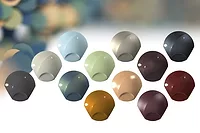BASF Releases 2018 Automotive Color Trends Analysis
SOUTHFIELD, MI – BASF has released its annual global analysis of color distribution in the automotive market for 2018.
Developed by the company’s Coatings division, the report, entitled BASF Color Report for Automotive OEM Coatings, finds that achromatic colors — white, black, gray and silver — still dominate the roads. They cover almost 80% of cars produced worldwide. White is the most popular color among them. More than one-fourth of North American cars and nearly one-third of European vehicles are painted white. More than half of the vehicles in Asia-Pacific are white. Silver’s popularity decreased slightly in comparison to the previous year.
Among the diverse range of color shades, blue is the most popular, followed by red. These chromatic colors tend to be more popular within the smaller vehicle segments, such as compact and subcompact cars. The overall amount of chromatic hues decreases significantly in the larger automobile segments. Here, there was a considerable increase in black and white compared to the previous year.
In 2018, the achromatics remained the most popular automotive colors for North America, accounting for roughly 75% of market production. Among the achromatic colors, white maintains the leading position. Besides the achromatic shades, consumers continued to demonstrate a growing affinity for red, specifically within the pickup and sports car segments. The diverse blue color space remained nearly the same compared to the prior year.
Over the last 10 years, crossover utility vehicles (CUV) have emerged as a dominant vehicle segment in North America. CUVs combine the qualities of sport utility vehicles (SUVs), such as safety and driving convenience, with benefits such as fuel efficiency to offer appealing features to a wide array of drivers. White is the most popular color in this segment, followed by black and gray. Car buyers almost equally desire blues and reds.
“In coating large surfaces for the CUV segment, the industry looks to bring a suitable visual expression of the vehicle’s perceived use and link it to the brand image,” said Paul Czornij, head of Automotive Color Design for BASF North America.
BASF’s Coatings division continuously monitors trends in materials and colors and uses this data to predict which colors will play a key role in the future automotive market. Each year, the Coatings division’s designers create Automotive Color Trends, an innovative collection of 65 new colors based on extensive research and in-depth analysis of global trends and cultural shifts that will influence automotive colors three to five years into the future.
Integrated into its color design innovations, BASF offers a range of sustainable coatings solutions for the automotive industry. Among these are coatings that enable a shortened application and curing process, which can reduce CO2 emissions by up to 20%, waterborne basecoats that meet strict global regulations to minimize the VOC content, and coatings with a temperature management functionality whereby the car surface does not heat up as much as conventional coatings, minimizing the heat build-up in interiors.
Looking for a reprint of this article?
From high-res PDFs to custom plaques, order your copy today!






